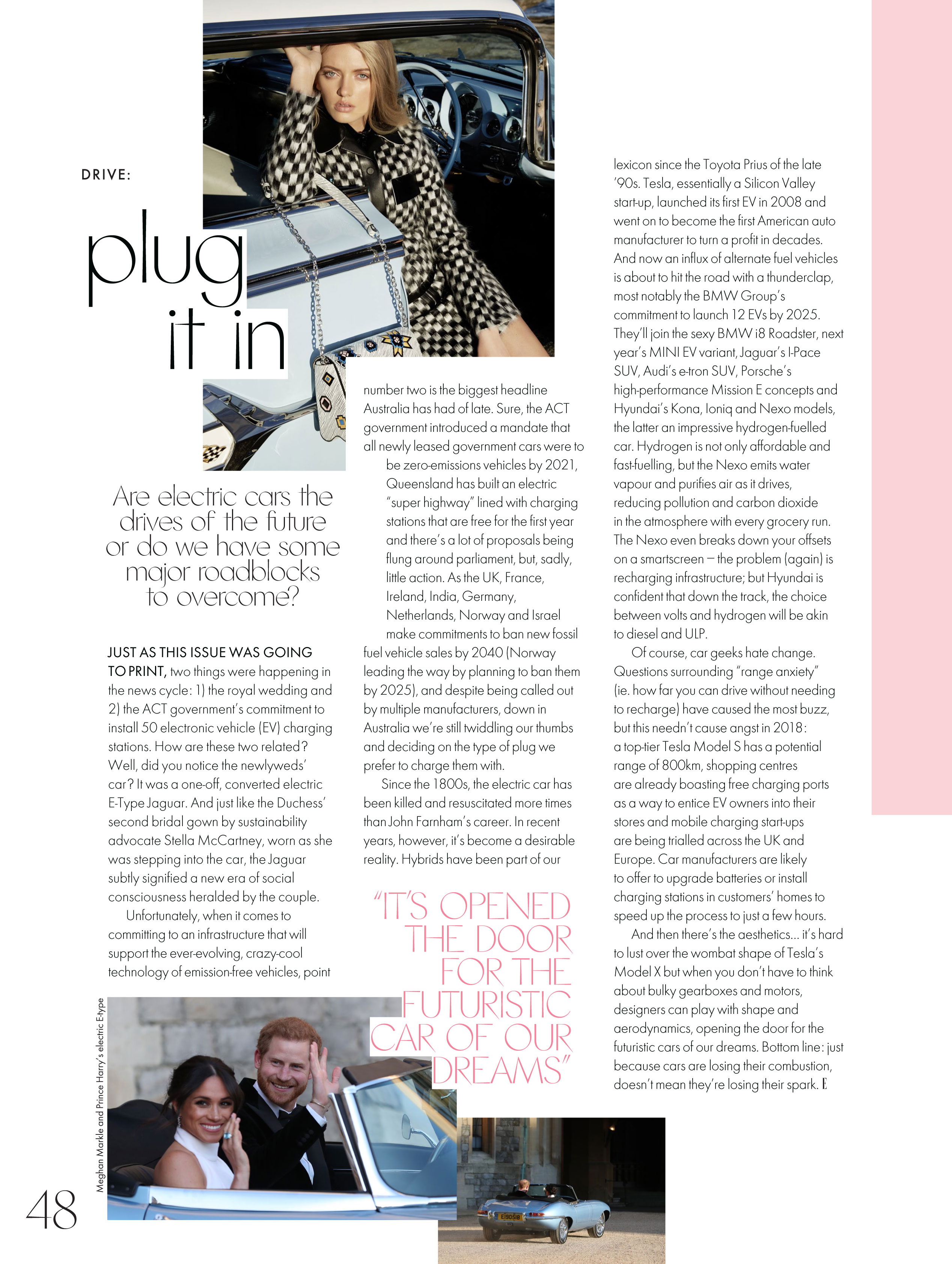
Are electric cars the drives of the future or do we have some major roadblocks to overcome?
Just as this issue was going to print, two things were happening in the news cycle: 1) the royal wedding and 2) the ACT government’s commitment to install 50 electronic vehicle (EV) charging stations. How are these two related? Well, did you notice the newlyweds’ car? It was a one-off, converted electric E-Type Jaguar. And just like the Duchess’ second bridal gown by sustainability advocate Stella McCartney, worn as she was stepping into the car, the Jaguar subtly signified a new era of social consciousness heralded by the couple.
Unfortunately, when it comes to committing to an infrastructure that will support the ever-evolving, crazy-cool technology of emission-free vehicles, point number two is the biggest headline Australia has had of late. Sure, the ACT government introduced a mandate that all newly leased government cars were to be zero-emissions vehicles by 2021, Queensland has built an electric “super highway” lined with charging stations that are free for the first year and there’s a lot of proposals being flung around parliament, but, sadly, little action.
As the UK, France, Ireland, India, Germany, Netherlands, Norway and Israel make commitments to ban new fossil
fuel vehicle sales by 2040 (Norway leading the way by planning to ban them by 2025), and despite being called out by multiple manufacturers, down in Australia we’re still twiddling our thumbs and deciding on the type of plug we prefer to charge them with.
Since the 1800s, the electric car has been killed and resuscitated more times than John Farnham’s career. In recent years, however, it’s become a desirable reality. Hybrids have been part of our lexicon since the Toyota Prius of the late ’90s. Tesla, essentially a Silicon Valley start-up, launched its first EV in 2008 and went on to become the first American auto manufacturer to turn a profit in decades. And now an influx of alternate fuel vehicles is about to hit the road with a thunderclap, most notably the BMW Group’s commitment to launch 12 EVs by 2025. They’ll join the sexy BMW i8 Roadster, next year’s MINI EV variant, Jaguar’s I-Pace SUV, Audi’s e-tron SUV, Porsche’s high-performance Mission E concepts and Hyundai’s Kona, Ioniq and Nexo models, the latter an impressive hydrogen-fuelled car. Hydrogen is not only affordable and fast-fuelling, but the Nexo emits water vapour and purifies air as it drives, reducing pollution and carbon dioxide in the atmosphere with every grocery run. The Nexo even breaks down your offsets on a smartscreen – the problem (again) is recharging infrastructure; but Hyundai is confident that down the track, the choice between volts and hydrogen will be akin to diesel and ULP.
Of course, car geeks hate change. Questions surrounding “range anxiety” (ie. how far you can drive without needing to recharge) have caused the most buzz, but this needn’t cause angst in 2018: a top-tier Tesla Model S has a potential range of 800km, shopping centres are already boasting free charging ports as a way to entice EV owners into their stores and mobile charging start-ups are being trialled across the UK and Europe. Car manufacturers are likely to offer to upgrade batteries or install charging stations in customers’ homes to speed up the process to just a few hours.
And then there’s the aesthetics... it’s hard to lust over the wombat shape of Tesla’s Model X but when you don’t have to think about bulky gearboxes and motors, designers can play with shape and aerodynamics, opening the door for the futuristic cars of our dreams. Bottom line: just because cars are losing their combustion, doesn’t mean they’re losing their spark.